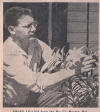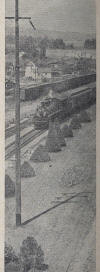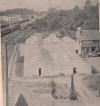|


| |
Great Northern's Green Thumb
by Howard E. Jackson
June 1954 issue of Railroad Magazine, Page 96

Croft Lilies from the Big G's Monroe, WA greenhouses
brighten the road's coaches, stations and gardens at
Easter. Here Tony deRooy puts finishing touches on
the white blossoms.
Click
Here for an additional story about the Monroe Greenhouse.
The busiest green thumb in railroading belongs to
Tony deRooy, the only florist we know of working
for a railroad. Tony's garden is the Great Northern
system with its countless miles of track, thousands
of cars, and hundreds of stations, stretching
from St. Paul like a spider web across the plains
and mountains and passes of the Northwest to
Seattle and the broad Pacific.
It's somehow fitting that the road used to be
Jim Hill's, who dreamed of making the prairie
blossom like a rose, should be the first and
only railroad we know of to set up its own
greenhouses and nursery plot for the sole purpose
of making the railroad a pleasanter way to
travel.
 
Tony DeRooy has the unique job of gardenering
the Great Northern's railroad greenhouses.
"All year through," Tony deRooy says, "we see to it
that there are flowers along the way for you
to look at
and enjoy. We have nothing to sell. We just
raise flowers."
This stocky young Dutchman who just raises flowers -
supervisor of parks, they call him, but he'd rather
think of himself as a time-table florist - is a quiet,
rather boyish-looking man with keen spectacled blue
eyes that can appraise a plant as skillfully as New
Englanders once could horses. Given the chance, Tony'll
spend hours with you talking about his job - his hobby
is dahlia raising, by which you know how well he likes
his work - but when he's on duty, there's no time to
waste. It's a full day's work keeping one of the
nation's largest railroads looking like Astor's Pet
House.
You can't travel many miles on the "Big G" without
discovering the unmistakable signs that Tony's been
here. That twenty-bud Easter lily you found yourself
admiring in the observation car (you couldn't help
yourself, incredulously you counted), and the fresh,
crisp pink carnations beside the carafe at your table
in the dining car, the anemones and jonquils and
lupines trembling brightly under the cool spring
sunlight in concrete boxes before that nameless
station you passed too quickly to identify - those
were the signs.
If you'd looked, you'd have seen a thousand others
along the line: Tony had been there. On the Great
Northern he's as often just been there as Kilroy
used to be - in other places, once upon a time.
Tony operates out of Monroe, Washington, forty
miles northeast of Seattle. There, within six
attached greenhouses - inside of which you could
build if you felt like it fifteen medium-sized
rambler type houses and have room left to spare -
he and his eight assistants yearly produce the
hundreds of thousands of cut flowers that flood
the dining cars and club cars of such famous
trains as the Empire Builder and the Western
Star.
Annually Tony and his crew grow as many as fifty
thousand potted plants, and thirty thousand flatted
bedding plants for the lines 220 station parks,
as well as for the mammoth gardens at the east
entrance to Glacier National Park where the
Great Northern maintains three large hotels and
five chalets. As park supervisor, Tony is also
responsible for landscaping those hundreds of
station grounds, and for replanting countless
window baskets and boxes at various installations
that do not have park areas.
As a florist, Tony is unique. He has to make
his flowers bloom with the split-second timing
of a magician. Come Easter Sunday, a thousand
gaily wrapped Croft lily plants in widely
scattered ticket offices, station restaurants,
and speeding trains must simultaneously burst
forth into more than five thousand stately
blossoms. During Easter Week, the dining cars
must be white with bouquets of cut lilies,
looking as fresh as they do in the fields. The
tender care Tony and his crew expend in cutting
and shipping their crop of cut flowers and the
carefully scheduled growth he subjects the
potted plants to explain their success in putting
on such a far-flung salute to the season.
The Easter displays are the high point of the year,
but these miracles go on all the time with
different flowers - carnations in January,
then daffodils - eighty five kinds of plants in all.
Flower-wise passengers are rightfully amazed to
find the same plants growing at the same time in
station parks in Everett and Spokane, at Bonners
Ferry, Great Falls, Fargo, and St. Paul. The trick
is not in the mere growing of a host of any one
kind, but in having five or ten thousand of the
same kind ready to be put in beds at the same
time, in various locations, and under variable
climatic conditions.
Some sleight-of-hand is necessary, for the seasons
differ as much as six weeks between the coast,
the prairie, and mountain station parks. Tony
solves this problem in the green houses by
"compensating" - growing some of the same kind early,
some late, accelerating the growth of backward plants
by means of heat, and retarding the growth of eager
beavers by putting them away temporarily in cold
storage.

Formal planting at Bonners Ferry, Ida., circles
monument commemorating first trade route across
the state. G.N. tries to suit station grounds
to countryside. Kids at gate catch up on local
history.

Showplace of the Great Northern birches, lawn,
spruces surround massed flowers at Whitefish,
Mont., station park where gardener-carman Paul
Gallo here offers a stalk of lupine to
Lucille Litton.
"The secret of raising flowers is not to be
too careful," Tony says. "Probably the most
common mistakes amateurs make are giving plants
too much water and heat, or watering them too
spasmodically, or moving the plants about with
resulting changes in temperatures, when they
should just be seeing that the plants grow
continually all the time."
The phone rings and Park Supervisor deRooy
answers.
"I want you to tell me what is wrong with
my poinsettia."
Tony gets that kind of phone call all the time.
Generally he can diagnose the "disease" by
having the person describe the plant, and
generally the plant has been badly treated,
permitted to grow too hot, too cold, too
drafty, too wet, pot-bound or pampered.
"Some people expect too much of plants," Tony
says. "Believe it or not, one passenger took
home an Easter lily, planted it in her garden,
and then wanted to know why it didn't remain
the beautiful lily she had seen in the
dining car!"
All of Tony's problems, as you can see,
aren't vegetable.
When he isn't worrying about the passengers
or his plants, Tony's got the hundreds of
station grounds and parks throughout the
system on his mind. Tony likes to keep
station grounds in character with their
surroundings. Bonners Ferry, for instance,
is a formal planting, and its focal point
is a monument commemorating the first trade
route across Idaho.
A caretaker with real pride in his station
gardens is Paul Gallo, a carman on the riptrack
who, since 1947, has devoted full time from
early spring through late fall to maintaining
the gardens at Whitefish, Montana. Great
Northern passengers recall Whitefish as a place
where great masses of violets, lupines or other
flowers tremble brightly under the summer breeze,
and where handsome birches rise behind green
lawns and a lordly fifty-foot spruce, which at
Christmas, is also in bloom - with colored lights.
"The new trend, however," Tony says, "is to put
concrete planter boxes around the stations to accent
the beauty of the buildings themselves - Sauk
Center's an example - but existing grounds,
of course, will be left as they are."
Tony's particular pride and joy is the ivy-covered
station at Everett, Washington, with its one and
a half acres of dahlia-studded grounds. All told,
the Everett beds contain around 250 dahlia plants.

New trend in station gardening is to put concrete
boxes around stations to accent the beauty of the
buildings themselves. New, white-walled Minnesota
depot contrasts with evergreen shrubs.
Under Tony's care, their blossoms grow to amazing
size, many of them to a diameter of more than
fourteen inches. Dahlias have been growing in
these beds for twenty-eight years now, he says,
and seem to do better each season.
Tony is as much railroad man as botanist-gardener.
It is his job not only to produce cut flowers
and plants in prodigious numbers but also to
ship them safely via the railroad to far-distant
points on a tight, time-table schedule. Tony
and his assistant Elliot Monroe, travel extensively
over the road, putting in the plantings at many of
the installations, and so he knows intimately
the men and women who keep the wheels turning
as well as those who work in the road's
commissaries to which the cut flowers are sent
and from which they are taken aboard the dining
cars along with the food.
Each cut flower is placed in an orchid tube, a
glass tube four inches long with a rubber cap
having a nipple-sized hole in it. The tube is
filled with flora-life preparation for keeping
the flower. Three tubes are paper-wrapped together
and along with hundreds of others, boxed and shipped
to the commissaries. When they are needed, the
flowers are removed from the tubes and placed
three or more to a bouquet, with greens, in
individual vases on each of the tables in the
dining cars. The potted plants are placed in
regular shipper's boxes with paper pillows to
keep them from rocking back and forth.
Of course once in a while Tony pulls a boner.
A while back, he was told to make up an
extra set of flowers for the dining room on a
train in Seattle. He used lilies he had on
hand to make up a floral display. The lilies
were placed in the dining room on the train
taking the University of Minnesota football
team back to Minnesota after it had been
beaten by the University of Washington. Lilies,
as you know, are associate with death, so the
Minnesota team didn't appreciate Tony's
flowers. The next day Tony received a telegram
from the superintendent of the commissary asking
who was the joker who sent the lilies!
Although Easter is the high point of the year,
Thanksgiving and Christmas are peaks, too. At
Christmas, cut figures and wreathes of Styrofoam,
pine cones, and bells are made up into displays
for the dining cars and stations. During the
Christmas season some two thousand dollars
worth of holly-berry corsages are given to
dining car patrons. It all costs money, but
the Big G feels it is money well spent.
People can't help being impressed by the
flowers in the trains and the station gardens.
The value of attractive stations and grounds
was first recognized by the Great Northern
years ago when the principle stations were
landscaped and cared for by agents. In 1925,
the system appointed George W. Dishmaker
supervisor of parks to assure greater uniformity
and better care of plantings along the line.
The next year the first of the greenhouses
was built and station parks were improved,
often with the help of local garden clubs.
When Dishmaker died in 1934, Andy deRooy,
Tony's father, took over the job of botanist
and supervisor of parks for the railway and held
the job until his death in 1951.
Tony was fortunate in inheriting a green thumb
from his father. But Tony's making the railroad's
Say-it-with-flowers tradition his own. He already
has six children, and he is trying to instill in
all of them a love for the flowers he is
devoting his life to.
THE END
Click
Here for an additional story about the Monroe Greenhouse.
  |